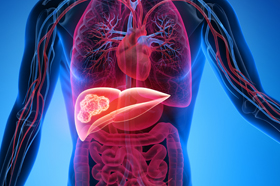Hepatic Delivery System for Unresectable Liver Cancers Demonstrates Increase in Overall Survival
 A retrospective analysis of patients who underwent a percutaneous hepatic perfusion procedure (PHP) with CHEMOSAT at three European centers reports a statistically significant difference in overall survival (OS) of 20 months vs. 8 months for patients who had two or more PHP procedures compared to patients who were treated with one PHP procedure.
A retrospective analysis of patients who underwent a percutaneous hepatic perfusion procedure (PHP) with CHEMOSAT at three European centers reports a statistically significant difference in overall survival (OS) of 20 months vs. 8 months for patients who had two or more PHP procedures compared to patients who were treated with one PHP procedure.
The study, published in Cardiovascular and Interventional Radiology, involved 101 patients who completed a minimum of one PHP procedure for the treatment of unresectable uveal melanoma (UM) liver metastases at three European centers between February 2014 and December 2019. It included a total of 212 PHP procedures for the 101 patients included in the study. Of the 101 patients, 66 received PHP as first line treatment and 33 had received prior therapy (status of 2 patients was unknown). Approximately 50% of patients had greater than 9 metastases. Seventy-seven patients underwent at least two procedures and 25 patients received more than two PHP procedures. After a median follow-up time of 15 months, a complete response (CR) was reported in five (5.0%) patients; partial response (PR) in 55 (54.5%), and stable disease (SD) in 30 (29.7%), resulting in an objective response rate (ORR) of 59.4% and a disease control rate (DCR) of 89.1%.
The median progression-free survival (PFS), liver progression-free survival (LPFS), and overall survival (OS) were 9.0 months (95% CI 7.7 -10.3); 11.0 months (95% CI 9.0 – 13.0); and 20.0 months (95% CI 13.7 – 26.3), respectively. Twelve patients who were lost to follow-up were censored in the survival analyses. The study also found statistically significant differences in median PFS, median LPFS, and OS between patients who had CR, PR, or SD; and patients with progressive disease (PD). For example, for patients with CR or PR the median OS was 27 months (95% CI 17.5 – 36.5); for patients with SD the median OS was 21 months (95% CI 11.2 – 30.8); and 8 months (95% CI 5.7 - 10.3) for patients with PD. The study did not find a statistically significant difference in either median PFS and LPFS for patients treated with two or more PHP procedures compared to patients treated with one PHP procedures.
The safety analysis was conducted on the first treatment cycle (183 PHP procedures). The most common adverse events were hematological toxicities which were grade 1/2 and self- limiting in the majority of patients and consistent with previous reports on PHP. Other adverse events were thromboembolic in nature. The mortality rate was 1.1% within 30 days after PHP.
"Delcath welcomes this publication and believes its results provide healthcare professionals with further evidence of Chemosat's utility in patients suffering from metastatic uveal melanoma," said Johnny John, MD, Delcath's Senior Vice President of Clinical Operations and Medical Affairs. "We look forward to resubmitting the NDA for Hepzato Kit, the combination of the Chemosat device packaged with melphalan, to FDA by the end of the third quarter."